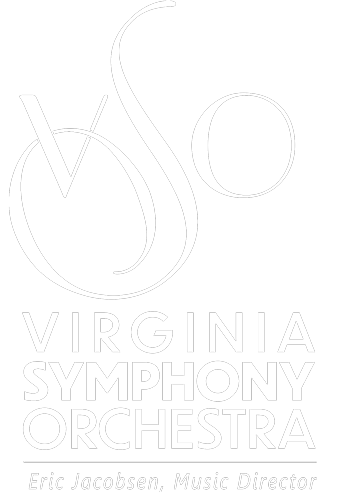5.1.18 | Virginia Symphony Orchestra members help and inspire Berkeley musicians
by Amelia Heymann
editor’s note: an earlier version of this story misidentified the VSO bassist Scott Harris.
A man sits in front of an upright bass half his size, clearly built for someone smaller.
“This is a tiny little bass where not even the bridge is placed right. Let’s see if I can fix this,” He said to no one in particular.
He slowly turns the bass’s pins while plucking the strings. When students arrive in the classroom, he surrenders it to someone who it fits a little better. However, the man tuning the bass is no ordinary music teacher, but Scott Harris, a bassist with the Virginia Symphony Orchestra.
On April 27, three members of the orchestra visited Berkeley Middle School as part of the School/Orchestra Artistic Residency. (Amelia Heymann)
Last Friday, three members of the Virginia Symphony Orchestra visited Berkeley Middle School as part of the School/Orchestra Artistic Residency program. This visit gave middle school orchestra students in-depth interactions with professional musicians.
The VSO describes SOAR this way: “An artist residency program matching VSO musicians with local schools for coaching and mentorship.” SOAR has been going into Williamsburg-James City County Schools for seven years. SO musicians visit W-JCC once a year, at no cost to the district. While the middle schooler’s visit involved hands-on playing, orchestra members also have visited elementary schools with programs that are closer to mini-concerts.
Harris said the educational outreach programs are funded through the education department of the VSO. According to their website, funds for the educational programs come from donations.
“We do enjoy doing it, but it is not all volunteer work, we get paid to do it,” Harris said.
The three visiting VSO members gave group and individual instruction to students. “They’re so great with the kids,” Berkeley Middle School’s orchestra teacher Amy Davis said in a whisper while watching the professionals instruct her students.
Simon Lapointe, the principal second violinist with the VSO, worked with Berkeley’s violinists on how to read and play music better. Lapointe said to make the music sound like it is supposed to, you need to play the notes with an inflection, just like speaking words. It’s like pronouncing words with an accent; if you play the note too soft or sharp, it doesn’t sound right.
Simon Lapointe, the principal second violinist at the VSO, worked one on one with violinists. (Amelia Heymann)
“Sounds better,” Davis said when she heard her students playing the same notes with the advice Lapointe had just given them.
After individual instruction, VSO members listened to the Berkeley Orchestra practice. Students were enthusiastic about getting to play their favorite piece, “Spartacus.”
While an outsider may have been impressed by the middle schooler’s performance, VSO members had some advice.
“My main comment is to listen to the other parts,” Lapointe told the violinists. “For most of this, you can rely on the cellists and bassists, they are the rolling rhythm for this piece.”
Two violinists at Berkeley Middle school practicing along with other students after receiving critique from a visiting Virginia Symphony Orchestra member. (Amelia Heymann)
After a brief critique, the performance improves immensely.
Deep notes of the bass section build drama, evolving from a dull rumble to an imposing thunder. The violas build on this mood, adding to the drama; violins follow, creating the climax of tension with their high notes. A crescendo of sound filled the auditorium — the rolling thunder of the bass contrasting with the sharp lightning sound of violin strings.
Harris said the reason he gets involved with the school outreach programs is because he believes music education needs to stay in schools.
“Music programs in the schools nurture creativity and it teaches the students how to socialize and how to work in a group,” he said.
Harris said a similar music program helped him growing up. When he went to high school in Georgia, there was a program where high school students traveled to Atlanta to play in the Atlanta Youth Symphony. They were coached by Atlanta Symphony musicians.
“My education, when I was in high school and playing for the Atlanta Youth Symphony and playing for the director Paul Mann at Roswell High School, was part of the things that shaped me as a person and gave me the passion to continue as a professional,” Harris said.
Students said they were motivated to continue music after working with professional musicians. Mckinnley Parker, a seventh-grade violin player, said she was moved by Satoko Rickenbacker, a violist with the VSO. Parker was inspired by how Satoko could play the violin and viola and wanted to be able to play both one day, too.
“I want to eventually make it into a large symphony like the Virginia Symphony,” Parker said.
While everyone can always improve, Harris said he thought the middle school students knew their music very well.
“They’ve been very disciplined, they listened,” Harris said. “I think if they keep playing music that will be a good thing for the rest of their lives.”
Want to learn more?
To learn more about the VSO’s SOAR program, visit virginiasymphony.org/educationcommunity-engagement. To help keep programs such as SOAR running, you can donate to the VSO online at virginiasymphony.org, or by mail to Virginia Symphony Orchestra Development, 150 Boush St., Suite 201, Norfolk, VA 23510.
